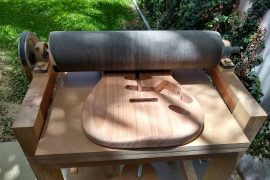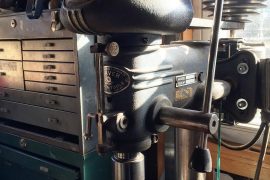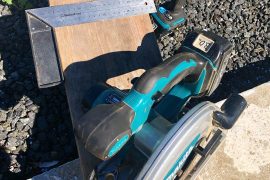Wood Thickness Planer:
The casual woodworker, most often perceives a wood planer to be a tool that takes rough lumber in at one end and offers “dressed” or planed lumber out the other end. It is critical to understand that when it cleans up the top face it is always doing it relative to the bottom face that is running on the planer’s table… thus it is often referred to as a wood thickness planer. It planes your wood to a thickness equal to the amount of space that you have left between the cutterhead and the top of the table or platen.
Portable Power Planer or Electric Planer?

It is not to be confused with a power or “electric” planer. These are small hand held tools that are used somewhat like a belt sander, but have blades instead of sanding belts.
Historically, their claim to fame has been in the home renovation industry where they are ideal for trimming a door edge, when the door opening is just not quite big enough. The planer blades are typically only a few inches in width and remove limited amounts of wood in a single pass… we’ll discuss that further in another section of this website.
Industrial wood thickness planers vs. bench mounted wood planers
Traditional wood planers or thickness planers can be floor or bench mounted depending on their size, your need to move them around, and the work load you expect to handle.
The degree of portability will determine many of its design features. Thus it is important to analyze your needs before hand. Buying solely on price can set you up for some level of disappointment. A cheap machine that can’t do what you want it to do, is just a cheap machine that sits in the corner taking up space.
Industrial Wood Planers
Industrial or commercial machines handle serious daily loads and heavy passes. They typically have a planning capacity between 18″ and 30″ although smaller and larger machines are available. They can handle woods up to and occasionally more than 8″ thick. They can weigh 400 to 1,000’s of pounds so there is no thought that they will be moved. Rather they are a permanent installation in a fixed wood shop, with a direct link to your in-house dust collection systems.
Their weight is intended to counterbalance the constant abuse of heavy lumber being dropped onto its table and the force of the feed rollers fighting to hold the wood into place. Weight can be used as one indicator of quality. It suggests that bearings and housings are made of metal, and not plastic (believe me plastic bushings instead of proper steel bearings are more common than you and I would like).
Some commercial wood planers are available for two sided operation and even have self adjusting “floating” heads that will balance the planing so that it takes the same amount of wood off from each side.. and it does this on the fly.
All industrial wood planers or “floor models” use “induction” or bushless motors that are rated on their continuous use horsepower output NOT peak load, thus they will always have more power then their portable cousins. A 3 hp induction motor is always SIGNIFICANTLY stronger than a 3ph universal motor found on things like plunge routers.
Portable Wood Thickness Planers

In the last couple of years, the industry has come up with a line of portable thickness planers. They were originally designed to appeal to the professional home renovator that wanted to setup a small woodworking shop in the back of the utility trailer so that it could be hauled to the jobsite. This offered greater job efficiency and a new level of sophistication on what could be handled at the clients home without a race back to the company workshop.
Benchtop Planers
For the hobbyist a portable thickness planer has become a hunt for the “best benchtop planer”. The portable part of the equation is not so important as is the fact that these planers are much smaller, thus more easily fit into the space constraints of a weekend woodworker’s shop. The price tag is also easier to swallow when you don’t have a business budget in which to justify its purchase.
But keep in mind that the original design was more about customizing already dressed wood. Thickness Planers, that is the portable versions are much lighter because they were meant to be portable. They were not intended for heavy use or aggressive planning of rough lumber… it doesn’t mean that they can’t do it. A Volkswagen beetle can pull your motorhome but it might only do it once! So be gentle!





